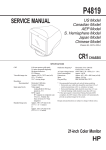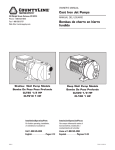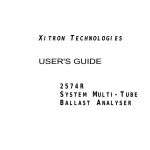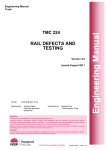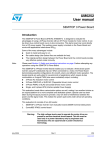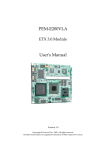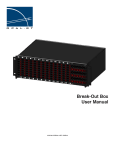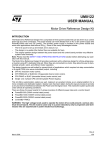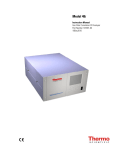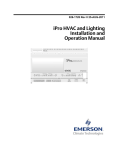Download KitchenAid KICU508SBL User's Manual
Transcript
KAC-47 TECHNICAL EDUCATION TOUCH-ACTIVATED ELECTRONIC INDUCTION COOKTOP MODELS: KICU508SBL & KICU568SBL JOB AID 4317409 FORWARD This KitchenAid Job Aid “Touch-Activated Electronic Induction Cooktop” (Part No. 4317409), provides the In-Home Service Professional with information on the installation, operation, and service of the Touch-Activated Electronic Induction Cooktop. For specific information on the model being serviced, refer to the “Use and Care Guide,” or “Wiring Diagram” provided with the cooktop. The Wiring Diagrams used in this Job Aid are typical and should be used for training purposes only. Always use the Wiring Diagram supplied with the product when servicing the cooktop. GOALS AND OBJECTIVES The goal of this Job Aid is to provide information that will enable the In-Home Service Professional to properly diagnose malfunctions and repair the Touch-Activated Electronic Induction Cooktop. The objectives of this Job Aid are to: • Understand and follow proper safety precautions. • Successfully troubleshoot and diagnose malfunctions. • Successfully perform necessary repairs. • Successfully return the cooktop to its proper operational status. WHIRLPOOL CORPORATION assumes no responsibility for any repairs made on our products by anyone other than authorized In-Home Service Professionals. Copyright © 2007, Whirlpool Corporation, Benton Harbor, MI 49022 - ii - TABLE OF CONTENTS Page GENERAL .............................................................................................................................. 1-1 Cooktop Safety .................................................................................................................. 1-1 Model & Serial Number Designations ................................................................................ 1-2 Model & Serial Number Label And Wiring Diagram Locations ........................................... 1-3 Specifications ..................................................................................................................... 1-4 INSTALLATION INFORMATION ............................................................................................ 2-1 Installation Instructions ...................................................................................................... 2-1 PRODUCT OPERATION ....................................................................................................... 3-1 Theory Of Operation .......................................................................................................... 3-1 Troubleshooting ................................................................................................................. 3-4 COMPONENT ACCESS ........................................................................................................ 4-1 Component Locations ........................................................................................................ 4-1 Removing The Cooktop Glass ........................................................................................... 4-2 Removing The Touch Control Board .................................................................................. 4-3 Removing An Induction Element Assembly ....................................................................... 4-4 Removing A Negative Temperature Coefficient (NTC) Sensor .......................................... 4-6 Removing A Cooling Fan And An Electronic Board ............................................................ 4-7 Removing A 20A Line Fuse ................................................................................................ 4-8 COMPONENT TESTING ........................................................................................................ 5-1 Induction Elements ............................................................................................................ 5-1 Negative Temperature Coefficient (NTC) Sensor............................................................... 5-2 Electronic Board IC Check ................................................................................................. 5-3 20A Line Fuses .................................................................................................................. 5-3 DIAGNOSTICS & TROUBLESHOOTING ............................................................................. 6-1 Electronic Board Error Codes ............................................................................................ 6-1 Touch Control Board Error Codes ...................................................................................... 6-2 WIRING DIAGRAMS ............................................................................................................. 7-1 30˝ Cooktop ...................................................................................................................... 7-1 36˝ Cooktop ...................................................................................................................... 7-2 - iii - — NOTES — - iv - GENERAL COOKTOP SAFETY Your safety and the safety of others are very important. We have provided many important safety messages in this manual and on the appliance. Always read and obey all safety messages. This is the safety alert symbol. This symbol alerts you to potential hazards that can kill or hurt you and others. All safety messages will follow the safety alert symbol and either the word “DANGER” or “WARNING.” These words mean: DANGER You can be killed or seriously injured if you don’t immediately follow instructions. WARNING You can be killed or seriously injured if you don’t follow instructions. All safety messages will tell you what the potential hazard is, tell you how to reduce the chance of injury, and tell you what can happen if the instructions are not followed. 1-1 MODEL & SERIAL NUMBER DESIGNATIONS MODEL NUMBER K IC U 50 PRODUCT GROUP K = KITCHENAID PRODUCT IDENTIFICATION EC = ELECTRIC COOKTOP GC = GAS COOKTOP IC = INDUCTION COOKTOP MERCHANDISING SCHEME C = CERAMIC GLASS S = STANDARD / PORCELAIN METAL T = TEMPERED GLASS U = ULTIMA V = VBL PRO LINE SERIES X = 208 VOLTS CAPACITY / SIZE / SERIES / CONFIGURATION 1ST POSITION 2ND POSITION 0 = 2 BURN. / ELEM. 0 = 30˝ WIDE 1 = STANDARD 2 = 42˝ OR 12˝ WIDE 2 = GRILL / GRIDDLE 3 = 33˝ WIDE 3 = TEMP. GLASS 5 = 15˝ WIDE 4 = COMMERCIAL 6 = 36˝ WIDE 5 = CERAMIC GLASS 8 = 48˝ WIDE FEATURE CODE 0 = STANDARD ELEMENTS / BURNERS 1 = RADIANT ELEMENTS 2 = DUAL ELEMENTS OR SEALED BURNERS W/GRILL 6 = 5 BURNERS / ELEMENTS 7 = HALOGEN ELEMENTS / OR 6 BURNERS 8 = TOUCH CONTROLS 9 = INDUCTION YEAR OF INTRODUCTION S = 2006 COLOR CODE BL = BLACK ENGINEERING CHANGE (0, 1, 2, ETC.) SERIAL NUMBER XT DIVISION RESPONSIBILITY XT = OXFORD YEAR OF PRODUCTION U = 2007 WEEK OF PRODUCTION 24 = 24TH WEEK PRODUCT SEQUENCE NUMBER U 24 01234 1-2 8 S BL 0 MODEL & SERIAL NUMBER LABEL AND WIRING DIAGRAM LOCATIONS The Model/Serial Number label and Wiring Diagram locations are shown below. Wiring Diagram Location (On Bottom Of Cooktop) Model & Serial Number Label Location 1-3 SPECIFICATIONS Model Number Model Description KICU508SBL KICU568SBL Touch Activated 36˝ Ceramic Touch Activated 30˝ Ceramic Premium Black Induction Cooktop Premium Black Induction Cooktop 30˝ 36˝ Size-Configuration Dimensions/Specifications Exterior Dimensions Overall Height (in) 3-1/4˝ 3-1/4˝ Overall Width (in) 31˝ 37˝ Overall Depth (in) 21-9/16˝ 21-9/16˝ Cutout Dimensions Burner Box Height 3˝ 3˝ Cutout Width (in) 29-1/2˝ 35-1/2˝ Cutout Depth (in) 20-1/2˝ 20-1/2˝ Weight Net Weight (lbs) 44.1 50.7 Ratings Electric Voltage/Phase/Frequency (Hz) 240/208 Volt,Single Phase,60Hz 240/208 Volt,Single Phase,60Hz Total Connected Load In kW 240 Volts (Preferred) 7.2 10.6 208 Volts 6.65 10.3 Circuit Amps 30 Amp (240V) / 32 Amp (208V) 45 Amp (240V) / 48 Amp (208V) Exterior Cooktop Finish Ceramic Glass Ceramic Glass Cooktop Color Premium Black Premium Black Cooktop Controls Touch Activated Touch Activated Cooktop Control Type LED LED Cooktop Control # 4 5 Electronic Control Yes - Touch Activated LED Control Yes - Touch Activated LED Control Keep Warm Yes (“h”) Yes (“h”) Keep Warm Switch Yes (Press + and - at the same time) Yes (Press + and - at the same time) Cooktop Features Power On Light 4 5 Autofocus Light No Yes Hot Surface Indicator 4 (“H”) 5 (“H”) Kitchen Timer Yes (99 Min.) Yes (99 Min.) Control Lock Yes Yes Ele R Front Size & Type 5-7/8˝ Single Induction 8-1/4˝ Single Induction Ele RF Output (W@240/208V) 1400W/1320W 2200W/2075W Ele L Front Size & Type 7-1/8˝ Single Induction 7-1/8˝ Single Induction Ele LF Output (W@240/208V) 1800W/1700W 1800W/1700W Ele R Rear Size & Type 5-7/8˝ Single Induction 11˝ Single Induction Ele RR Output (W@240/208V) 2400W/2200W 1400W/1320W Ele L Rear Size & Type 7-1/8˝ Single Induction 7-1/8˝ Single Induction Ele LR Output (W@240/208V) 1800W/1700W 1800W/1700W Ele C Front Size & Type 11˝/ 7-1/8˝ Dual Zone Induction Ele CF Output (W@240/208V) 3600W - 1800W/3120 - 1700W 1-4 Model Number Miscellaneous Product Literature Installation Instructions Parts List Service Manual/Job Aid Tech Sheet Use & Care Guide Other Agency Approvals Approved to Install Over BI Oven Hardware Power Cord Length & # Wires Residential Use Only Warranty Limited Extended Ceramic Glass Cooking Surface Electronic Controls Electrical Elements KICU508SBL KICU568SBL Yes Yes Yes Yes Yes Yes Yes Yes Yes Yes UL, CUL Yes Yes 3 Foot/3 Wire Yes UL, CUL Yes Yes 3 Foot/3 Wire Yes 12 Mo 12 Mo 60 Mo. Parts only 60 Mo. Parts only 60 Mo. Parts only 60 Mo. Parts Only 60 Mo. Parts Only 60 Mo. Parts Only 1-5 — NOTES — 1-6 INSTALLATION INFORMATION INSTALLATION INSTRUCTIONS INSTALL HEAT SHIELD 1. 4. Decide on the final location for the cooktop. WARNING B Excessive Weight Hazard Use two or more people to move and install cooktop. Failure to do so can result in back or other injury. 2. 3. A Using two screws, reattach the heat shield to the underside of the cooktop at the predrilled holes as shown in the following illustration. A Using two or more people, place the cooktop upside down on a covered work surface. Remove the heat shield from the cooktop. Set the two screws aside for reattaching the heat shield. A. Heat shield B. Predrilled holes INSTALL COOKTOP Style 1: Cooktop over undercounter built-in oven IMPORTANT: • Your cooktop may not be approved for use over an undercounter built-in oven. Contact your dealer to confirm that your cooktop is approved. • Clamping brackets should not be used. B 1. 2. A. Heat shield B. Remove screws 2-1 Turn cooktop right side up. Place cooktop in cutout. NOTE: Make sure that the front edge of the cooktop is parallel to the front edge of the countertop. If repositioning is needed, lift entire cooktop up from cutout to avoid scratching the countertop. 2. Style 2: Cooktop over cabinets 1. Determine whether your cabinet construction provides clearance for installing clamping brackets at cooktop base ends. This is the recommended location. Clamping brackets can be installed on the back of cooktop base bottom, if necessary. 3. 4. A 5. B A. Attachment screw holes, side or back locations B. Front of cooktop Rotate brackets so they do not extend beyond edge of cooktop base. Tighten screws enough to hold brackets in place when cooktop is placed into the cutout. Turn the cooktop right side up and place in cutout. NOTE: Make sure that the front edge of the cooktop is parallel to the front edge of the countertop. If repositioning is needed, lift entire cooktop up from cutout to avoid scratching the countertop. Loosen the screws and rotate the brackets so that they are perpendicular to the edge of the cooktop base and extend beyond its edge. Securely tighten screws. Installing Brackets After Placing Cooktop in Cutout 1. Place cooktop in cutout. NOTE: Make sure that the front edge of the cooktop is parallel to the front edge of the countertop. If repositioning is needed, lift entire cooktop up from cutout to avoid scratching the countertop. 2. Position clamping bracket to allow the bracket to extend far enough out from the cooktop for the installation of 2-1/2˝ (6.4 cm) clamping screws 2. The clamping brackets can be installed before or after the cooktop is placed into the cutout. Complete the following steps for the option you choose. Installing Brackets Before Placing Cooktop in Cutout 1. Position bracket to allow the clamping bracket to extend far enough out from the cooktop for the installation of 2-1/2˝ (6.4 cm) clamping screws. See “Attach Cooktop to Countertop” for illustration of clamping screw installation. A G F E D B C A A. Glass cooktop B. Cooktop base C. Attachment screw D. Clamping bracket (extends far enough beyond cooktop base to allow installation of clamping screws) B C A. Clamping bracket B. Attachment screw and washer C. Clamping screw 3. 2-2 E. 2-1/2" (6.4 cm) clamping screw (to be installed in “Attach Cooktop to Countertop” section) F. Countertop G. Foam seal Attach brackets to cooktop base bottom with bracket attachment screws using the bracket mounting holes. Securely tighten screws. MAKE ELECTRICAL CONNECTION 4-Wire Cable from Home Power Supply IMPORTANT: Use the 4-wire cable from home power supply in the U.S. where local codes do not allow grounding through neutral, New Branch circuit installations (1996 NEC), mobile homes and recreational vehicles, new construction, and in Canada. WARNING A Electrical Shock Hazard Disconnect power before servicing. Use 8 gauge copper wire. Electrically ground cooktop. Failure to follow these instructions can result in death, fire, or electrical shock. B G C D This cooktop is manufactured with a frame-connected, green (or bare) ground wire. 1. Disconnect power. 2. Remove junction box cover if it is present. 3. Connect the flexible cable conduit from the cooktop to the junction box using a UL listed or CSA approved conduit connector. 1. A 3. A. UL listed or CSA approved conduit connector 5. Tighten screws on conduit connector if present. See “Electrical Connection Options Chart” to complete installation for your type of electrical connection. 4. Electrical Connection Options Chart If your home has: Go to Section: 4-wire 4-Wire Cable from Home Power Supply 5. ½" (1.3 cm) 3-wire H I F. White wire (from home A. Cable from home power power supply) supply G. UL listed wire connector B. Red wires C. Green (or bare) ground wire H. Black wires (from cooktop) I. UL listed or CSA approved conduit connector with D. 3-Wire cable from cooktop wire bushing E. Junction box 2. 4. E F 3-Wire Cable from Home Power Supply ½" (1.3 cm) 2-3 Connect the two red wires (B) together using a UL listed wire connector. Connect the green (or bare) ground wire (C) from the cooktop cable to the green (or bare) ground wire (in the junction box) using a UL listed wire connector. Put a UL listed wire connector on the end of the white wire (F). NOTE: Do not connect the green (or bare) ground wire to the neutral (white) wire in the junction box. Connect the two black wires (H) together using a UL listed wire connector. Install junction box cover. ATTACH COOKTOP TO COUNTERTOP 3-Wire Cable from Home Power Supply - U.S. Only IMPORTANT: Use the 3-wire cable from power supply where local codes permit a 3-wire connection. A NOTE: This section applies only if you are using clamping brackets. D E C B A B F G A. Clamping screw B. Countertop C. Foam seal D. Cooktop H C I D A. Cable from home power supply B. Red wires C. Green (or bare) ground wire from cooktop D. 3-wire cable (from cooktop) E. Junction box 1. 2. 3. 4. 1. F. White wire (from home power supply) G. UL listed wire connector H. Black wires I. UL listed or CSA approved conduit connector with wire bushing 2. 3. Connect the two red wires (B) together using a UL listed wire connector. Connect the green (or bare) cooktop cable wire (C) to the white (neutral) wire (F) in the junction box using a UL listed wire connector. Connect the two black wires (H) together using a UL listed wire connector. Install junction box cover. 2-4 Place the 2-1/2˝ (6.4 cm) clamping screws into the brackets. Check that the cooktop is level. Use a flat-blade screwdriver to tighten the screws against the countertop. Do not overtighten. PRODUCT OPERATION THEORY OF OPERATION Principles Of Induction Heating A temperature sensor under the glass is used in order to protect the inductor, and it moreover allows detecting that an empty container is being over-heated and stopping the heating process. The use of induction heating in glass-ceramic cooking devices has existed since 1987. With this technique, the container is heated directly. Therefore the cooking surface heats up only as a result of the heat transmitted from the container to the glass, which is much lower than in conventional systems. The base of the container is heated by the electric currents that circulate in its base and which are induced by a variable, medium-frequency magnetic field generated by the inductors located underneath the ceramic glass. Only containers with a base made of ferromagnetic steel or iron can be used with induction cooktops. Containers that cannot be used for induction can be recognized by a magnet test. Even though it is recommendable to use containers that fit the size of the cooking zone, containers of a smaller diameter can be used without causing notable reductions of efficiency. The cooktop control reduces the power delivered to small containers and, if applicable, stops supplying power when the container does not have the minimum required diameter. Advantages Of Induction Heating Faster Cycle Time • Heat is developed directly and instantly within 1 second inside the pot or pan, allowing a much quicker startup than other heating equipment. Heating process times can be dramatically reduced & production output can be significantly increased. • With induction cooking the heat level is every bit as instantaneous, and as exact, as with gas, yet with none of the many drawbacks of gas (carbon monoxide, loss of flame etc.). Induction elements can be adjusted to increments as fine as the cooking utensil cares to supply, just like gas, and—again very important to serious cooks—such elements can run at as low a cooking-heat level as wanted for gentle simmering and suchlike (something even gas is not always good at). The power inverter transforms the 50 Hz of the power grid into an alternating current with a frequency between 20 and 60 Hz. Direct heating of the container base provides the induction system with very fast heating. Likewise, the system reacts very quickly to power level changes. Induction provides very precise control of the power levels, wherefore it allows delicate recipes to be prepared. High Thermal Efficiency And Increased Profitability • This energy-efficient process converts up to 90% of the energy expended into useful heat to reduce utility costs. (With gas ranges up to 60% of the heat is normally wasted through indirect gas combustion.) Stand-by losses are reduced to a minimum. • The costs of exhaust duct installation and air conditioning running costs are saved. 3-1 User-Friendly • As mentioned earlier, induction cooking energy is supplied directly to the cooking utensil by the magnetic field; thus, almost all of the source energy gets transferred to that cooking utensil. With gas or conventional electric elements (including halogen), the energy is first converted to heat and only then directed to the pot or pan with a lot of that heat going to waste heating up your kitchen instead of heating up your food. (As a comparison, 40%—less than half—of the energy in gas gets used to cook, whereas with induction 84% percent of the energy in the electricity used gets used to cook (and the rest is not waste heat as it is with gas). There are two important heat-related consequences of that fact: • Working conditions are improved with the absence of smoke and heat produced by heating equipment. You can touch the outer casing without getting burned. • If the electricity supply to your home is interrupted, you will be unable to cook; gas supplies can be interrupted, too, but such interruptions are normally somewhat less likely than electricity interruptions. If the electricity where you are frequently goes out for hours at a time, the loss of cooking ability may be an issue for you. Pinpoint Accuracy • Power input is precisely controlled to achieve the exact temperature required for heating. Heat is developed directly inside the pot or kettle or cooktop. • With gas, when you adjust the element setting, the energy flow adjusts instantly. • But with induction cooking the heat level is every bit as instantaneous, and as exact, as with gas, yet with none of the many drawbacks of gas. Induction elements can be adjusted to increments as fine as the cooker maker cares to supply, just like gas, and—again very important to serious cooks—such elements can run at as low a cooking-heat level as wanted for gentle simmering and suchlike (something even gas is not always good at). • Moreover, gas—induction’s only real competition—has special risks of its own, not all of which are as well known as they perhaps should be. While the risk of a gas flame, even a pilot light, blowing out and allowing gas to escape into the house is relatively small, it does exist. Cooler kitchens: • Of course the cooking vessel and the food itself will radiate some of their heat into the cooking area—but compared to gas or other forms of electrically powered cooking, induction makes for a much cooler kitchen. Cool stove top: • The stove top itself barely gets warm except directly under the pan (and that only from such heat as the pan bottom transfers). No more burned fingers, no more baked-on spills, no more danger with children around. Environmentally Sound • Induction heating is a clean, non-polluting process. It produces much less smoke or waste heat to alter the surrounding environment. • It is an obvious but still very important fact that induction cooktops are powered by electricity. Not every home actually has a gas pipeline available to it—for many, the only “gas” option is propane, with the huge propane tank and regular truck visits. But everyone has clean, silent, ever-present electricity. • Burning gas has byproducts that are vaporized, but eventually condense on a surface somewhere in the vicinity of the cooktop. Electrical cooking of any kind eliminates such byproducts. Maximum Repeatability • With modern induction heating equipment, the heating pattern is always the same for a given set-up, cycle after cycle and day after day. 3-2 Noises that are Common to the Normal Operation of Induction Cooktops different speeds according to the temperature detected. The fan can also continue operating when the cooktop is turned off after being used if the detected temperature continues to be high. NOTE: All these noises are normal and inherent to induction technology, and they are not a sign of any breakdown. The noises that occur with greatest frequency are those with containers that have a “sandwich” type base. Induction heating technology is based on the capacity that certain metal materials have to vibrate when they are subject to high frequency waves. Under certain circumstances, these vibrations may make certain sounds of a low volume due to the following: • Low tone noise, similar to that of a transformer: It occurs when cooking at high power levels. It is due to the enormous amount of energy that the cooktop is supplying to the container. It disappears or attenuates as the power level used is reduced. • Soft whistling: They occur when the container is empty. They disappear or attenuate when water or the food to be cooked is added. • Crackling: This kind of noise may occur in containers composed of layers of different materials. The noise is due to the vibration in the separation zones between the various layers of material. This noise is proper to the container. It can change according to the quantity and type of food that is cooked. • Sharp whistling (beeps): They occur basically with containers composed of different layers of materials when two adjacent cooking zones are started up at the same time and at maximum power. They disappear or attenuate when the power is reduced. • Intermittent clicks: They are noises caused by the commutations of the control electronics, above all when low power levels are selected. • Fan noise: In order to control the correct operation of the electronics, they must work at a controlled temperature. To achieve this, the cooktop is equipped with a fan that works at Overview of Induction Cookware • All pots and pans with a ferromagnetic base are valid for induction. • Only containers that have a base where a magnet remains adhered can be used. • The induction system does not heat up other kinds of containers, and the power level indicator on the display will blink. • The minimum diameter of the container must likewise be taken into account. Pots and Pans good for Induction Cooking • Enamelled steel pots and pans. • Cast iron pots and pans. • Special stainless steel utensils for induction cooking. Pots and Pans not good for Induction Cooking • • • • • • • 3-3 Non-ferromagnetic or non-metallic materials. Aluminum pots and pans. Copper pots and pans. Brass pots and pans. Standard stainless pots and pans. Glass (“Pyrex”) containers. Earthenware pans. TROUBLESHOOTING Display shows messages Nothing will operate • Is “E” flashing on the surface cooking area display? Thoroughly wipe or remove any object on touch keys. When finished cleaning, touch the correct key. The flashing should stop. • Is “E” flashing on all the surface cooking area displays with a signal beeping? The main switch has been kept on for more than 5 seconds. Wipe up any soil on the touch keys. Remove any objects on the touch keys. Reset the cooktop. • Is the display flashing when you place a saucepan on an induction surface cooking area? Check that the saucepan is magnetic. Check that the diameter of the saucepan is large enough. Center the saucepan on the surface cooking area. Allow the saucepan to cool down in the event that it has become hot when used. Switch the surface cooking area off, then on again. If the display still does not light up, turn power off at the circuit breaker. Wait 20 seconds and turn power back on. • Is the Performance boost function display flashing and switching off? The Performance boost function operates the surface cooking area with the most power. During long cooking times, it is possible that the function will switch the surface cooking area off to protect the cooktop from overheating. You can continue to use the cooktop if the display is not flashing. • Is the cooktop wired properly? See the Installation Instructions for more information. • Has a household fuse blown, or has a circuit breaker tripped? Replace the fuse or reset the circuit breaker. If the problem continues, call an electrician. Cooktop will not operate • Is the cooktop control set correctly? Touch SELECT before selecting a setting. • Is the “Control Lock” Cooktop Lockout set? See “Control Lock” in the Use & Care Guide. • Has the cooktop turned off by itself? The power off key was unintentionally touched. Press power key again. Reset the cooktop. Excessive heat around cookware on cooktop • Is the cookware the proper size? Use cookware about the same size as the surface cooking area. Cookware should not extend more than 1/2˝ (1.3 cm) outside the cooking area. Cooktop cooking results not what expected • Is the proper cookware being used? See “Cookware” in the Use & Care Guide. • Is the cooktop control set to the proper heat level? See “Cooktop Controls” in the Use & Care Guide. • Is the appliance level? Level the appliance. See the Installation Instructions. 3-4 • Is the display flashing “Er” and numbers? If an “Er” and a series of numbers appear in the display panel, turn power off at the circuit breaker. Turn on again. If a problem continues, call customer service. See “Assistance or Service” in the Use & Care Guide. • Is the display flashing “F” and numbers? If “F” and a number are alternately flashing on the display, refer to the following table for possible solutions. Error Code Error Operational cooktop sounds • Is there a low humming? This occurs when cooking at high power. The cause of this is the amount of energy which is transmitted from the appliance to the cookware. This sound will quiet or go away when the power is turned down. • Is there a crackling? This sound occurs when cookware is used which consists of different materials. The noise is caused by vibrations in the joint faces between the different layers. It may change depending on the amount and type of food being cooked. • Is there a fan noise? The electronics require a controlled temperature in order to function reliably. The cooktop is fitted with a fan which runs at various speeds according to the temperature detected. The fan may also continue to run even after the cooktop has been switched off, if the temperature it detects is too high. Solution F0 An internal error was detected. Disconnect power. Wait 5 seconds before reconnecting power. If the symbol appears again, call customer service. F2 The surface cooking area is too hot and has turned off. Remove the pans from the surface cooking area. “F2” will disappear when the surface cooking area has cooled down. If you turn the surface cooking area back on and “F2” reappears, the cooktop is still too hot. Turn off the surface cooking area and allow it to cool. F4 The pot or pan is too close to the control panel. Make sure the pot or pan is centered on the surface cooking area and nothing hot is on the touch control panel. Wait 5 minutes for control panel to cool. If “F4” appears after turning the surface cooking area back on, call customer service. F8 The surface The surface cooking area cooking area has automatic shutoff was activated. been in operation Turn off the surface cooking area. for too long. c1 The power voltage is too low. c2/c3 The surface The surface cooking area cooking area has automatic shutoff was activated. overheated. Wait 5 minutes, for it to cool down, then turn it back on. Turn off the cooktop. Wait 5 seconds, then turn it back on. If this continues, contact a qualified electrician. 3-5 — NOTES — 3-6 COMPONENT ACCESS This section instructs you on how to service each component inside the KitchenAid Touch-Activated Electronic Induction Cooktop. The components and their locations are shown below. COMPONENT LOCATIONS Negative Temperature Coefficient (NTC) Sensor (1 For Each Element) Left Induction Element Assembly Touch Control Board Left Cooling Fan Right Induction Element Assembly Right Cooling Fan Left Electronic Board Right Electronic Board 2 20A Fuses (Inside Burner Box) 4-1 REMOVING THE COOKTOP GLASS 3. WARNING 4. Remove the fourteen flat-head screws from the front, rear, and side ceramic glass brackets. Remove the two small side brackets from the cooktop base. Fron t/Re ar B rack Cooktop Glass et Sc rews Electrical Shock Hazard Disconnect power before servicing. Replace all parts and panels before operating. Failure to do so can result in death or electrical shock. Side Bracket Screws 1. 2. Unplug cooktop or disconnect power. Remove the cooktop from its mounting location, (see “Installation Instructions” in Section 2). Position the cooktop so that you can access the bracket screws below the cooktop glass. Small Side Bracket Cooktop Base 5. Lift and remove the ceramic glass from the cooktop base. Cooktop Glass 4-2 REMOVING THE TOUCH CONTROL BOARD 3. WARNING Press and unlock the two holder tabs, raise the touch control board, and remove the board from the holder. Touch Control Board Holder Tabs Electrical Shock Hazard Disconnect power before servicing. Replace all parts and panels before operating. Failure to do so can result in death or electrical shock. 1. 2. 4. Slide the three edge connectors off the touch control board. Touch Control Board Connectors Unplug cooktop or disconnect power. Remove the cooktop glass from the cooktop (see page 4-2 for the procedure). 5. To remove the touch control board holder, remove the four mounting screws. Touch Control Board Holder & Screws Touch Control Board 4-3 REMOVING AN INDUCTION ELEMENT ASSEMBLY WARNING Electrical Shock Hazard Disconnect power before servicing. Replace all parts and panels before operating. Failure to do so can result in death or electrical shock. 1. 2. Left Induction Element Mounting Plate Screws (3) Unplug cooktop or disconnect power. Remove the cooktop glass from the cooktop (see page 4-2 for the procedure). Right Induction Element Mounting Plate Screws (4) Left Induction Elements 3. Right Induction Elements Remove the screws from the left or right induction element assembly mounting plate (see the right photos). 4-4 4. Disconnect the induction element assembly connectors from the electronic board as follows: 2-wire connector at CNT3. 2-wire connector at CNT1. Red wire at FST1. Green wire at FST2. Induction element screw terminals at CNX1, CNX2, CNX3 & CNX4. FST2 5. 6. LR Element Cover & Tabs FST1 CNT1 Left Induction Element Assembly Shown Remove the induction element assembly from the cooktop. Unhook the two cover tabs and remove the cover from the induction element you are replacing. LF Element Cover & Tabs CNX2 CNX1 Left Induction Element Assembly CNX3 CNX4 CNT3 Electronic Board RR Element Cover & Tabs RF Element Cover & Tabs Right Induction Element Assembly 4-5 REMOVING A NEGATIVE TEMPERATURE COEFFICIENT (NTC) SENSOR WARNING 5. Electrical Shock Hazard Disconnect power before servicing. Replace all parts and panels before operating. Failure to do so can result in death or electrical shock. 1. 2. Unplug the NTC sensor connector from the electronic board as shown in the chart below. NOTE: If necessary, refer to the Wiring Diagrams in Section 7 for the connector locations. ELEMENT LOCATION NTC CONNECTOR LF CNT3 (LEB) LR CNT1 (LEB) C CNT1 (MEB) RF CNT3 (REB) RR CNT1 (REB) LEB = Left Electronic Board MEB = Middle Electronic Board (5 element models) REB = Right Electronic Board Unplug cooktop or disconnect power. Remove the cooktop glass from the cooktop (see page 4-2 for the procedure). 6. Unhook the tabs on the NTC sensor, pull the sensor off the element, and remove it. Tabs NTC Sensor Left NTC Sensors 3. 4. Right NTC Sensors Depending on the negative temperature coefficient (NTC) sensor you are servicing, remove the screws from the left or right induction element assembly mounting plate (see page 4-4 for the procedure). Unhook the two cover tabs and remove the cover from the induction element NTC sensor you are replacing (see page 4-5 for the procedure). Tabs 4-6 REMOVING A COOLING FAN AND AN ELECTRONIC BOARD WARNING Electronic Board Cooling Fan Electrical Shock Hazard Disconnect power before servicing. Replace all parts and panels before operating. Failure to do so can result in death or electrical shock. 1. 2. 3. CNT5 5. Unplug cooktop or disconnect power. Remove the cooktop glass from the cooktop (see page 4-2 for the procedure). Remove the left or right induction element assembly, depending on which cooling fan or electronic board you are removing (see page 4-4 for the procedure). Left Cooling Fan Tabs Right Cooling Fan To remove an electronic board: a) Remove the cooling fan (see step 4). b) Disconnect the following wires from the electronic board terminals: Black at N. Red at L. Green at FST3 4-wire connector at CNT4. c) Press and unlock the two tabs from the right side of the board and lift the electronic board from its holder. GN (FST3) RD (L) BK (N) Tab Electronic Board Left Electronic Board 4. Right Electronic Board To remove a cooling fan (see the top right photo): a) Disconnect the 2-wire fan connector from electronic board pins CNT5. b) Press and unlock the two tabs from the cooling fan and lift the fan from the electronic board. CNT4 4-7 Tab REMOVING A 20A LINE FUSE 4. WARNING LIft the front of the component panel approximately 8˝, disconnect the 4-wire bridge communication cable connector, and rest the panel back against a support. Component Panel Electrical Shock Hazard Disconnect power before servicing. Replace all parts and panels before operating. Failure to do so can result in death or electrical shock. 4-Wire Bridge Communication Cable Connector NOTE: A fuse is installed for each relay board to avoid short circuits in the cooktop. 1. Unplug cooktop or disconnect power. 2. Remove the cooktop glass from the cooktop (see page 4-2 for the procedure). 3. Remove the ten flat-head screws from the component panel and burner box. 5. Remove the defective fuse from its fuse holder clips and install a new 20A fuse in its place. Component Panel Burner Box Screw (1 of 10) 20A Line Fuses 4-8 COMPONENT TESTING • Check all connections before replacing components, looking for broken or loose wires, failed terminals, or wires not pressed into connectors far enough. • Resistance checks must be made with power cord unplugged from outlet, and with wiring harness or connectors disconnected. Before testing any of the components, perform the following checks: • The most common cause for control failure is corrosion on connectors. Therefore, disconnecting and reconnecting wires will be necessary throughout test procedures. • All tests/checks should be made with a VOM or DVM having a sensitivity of 20,000 ohms-per-volt DC, or greater. WARNING Electrical Shock Hazard Disconnect power before servicing. Replace all parts and panels before operating. Failure to do so can result in death or electrical shock. Refer to page 4-4 for the procedure for accessing the induction elements. 1. Unplug cooktop or disconnect power. 2. Disconnect the induction element wires from the electronic board. 3. Set the ohmmeter to the R x 1 scale. 4. Touch the ohmmeter test leads to the induction element wire terminals. The meter should indicate less than 1 Ω. INDUCTION ELEMENTS Level 0 1 1-1/2 2 2-1/2 3 3-1/2 4 4-1/2 5 5-1/2 6 6-1/2 7 7-1/2 8 8-1/2 9 B 5.90˝ Small (%) 0.0 2.7 4.0 5.4 6.7 9.3 10.7 13.4 16.1 18.8 21.4 25.5 30.8 37.5 45.5 54.9 68.3 100.0 128.6 (W) 0.0 37.2 56.4 75.6 93.6 130.8 150 187.2 225.6 262.8 300 356.4 430.8 525.6 637.2 769.2 956.4 1400 1800 7.08˝ Medium (%) 0.0 2.9 4.4 6.0 7.4 10.3 11.8 14.7 17.8 20.7 23.6 28.1 33.9 41.4 50.2 60.5 75.3 100.0 141.7 (W) 0.0 52.7 79.9 107.1 132.6 185.6 212.5 265.2 319.6 372.3 425.0 504.9 610.3 744.6 902.7 1089.7 1354.9 1800.0 2500.0 8.27˝ Big (%) 0 3.1 4.7 6.3 7.8 10.9 12.5 15.6 18.8 21.9 25.1 29.7 35.9 43.8 53.1 64.1 79.7 100.0 150.0 Level (W) 0 68.2 103.4 138.6 171.6 239.8 275.0 343.2 413.6 431.8 550.0 653.4 789.8 963.6 1168.2 1410.2 1753.4 2200.0 3300.0 0 1 1-1/2 2 2-1/2 3 3-1/2 4 4-1/2 5 5-1/2 6 6-1/2 7 7-1/2 8 8-1/2 9 B 5-1 11.02*7.08˝ Big (%) 0.0 3.1 4.7 6.3 7.8 10.9 12.5 15.6 18.8 21.9 25.0 29.7 35.9 43.8 53.1 64.1 79.7 100.0 100.0 (W ) 0 77.5 117.5 157.5 195.0 272.5 312.5 390.0 470.0 547.5 625.0 742.5 897.5 1095.0 1327.5 1602.5 1992.5 2500.0 2500.0 WARNING Electrical Shock Hazard Disconnect power before servicing. Replace all parts and panels before operating. Failure to do so can result in death or electrical shock. NEGATIVE TEMPERATURE COEFFICIENT (NTC) SENSOR Refer to page 4-6 for the procedure for accessing the negative temperature coefficient (NTC) sensor. NOTE: Each of the inductors uses a negative temperature coefficient (NTC) sensor for monitoring the operating temperature. The sensors are interchangeable. Use conductive grease when replacing a sensor to aid in thermal conduction. 1. Unplug cooktop or disconnect power. 2. Disconnect the NTC wires from the electronic board. 3. Set the ohmmeter to the R x 1 scale. 4. Touch one of the ohmmeter test leads to the pins of the NTC connector. The meter should indicate as shown in the charts. 5-2 Temp (°F) R (k Ω) Temp (°F) R (k Ω) 50 51.8 53.6 55.4 57.2 59 60.8 62.6 64.4 66.2 68 69.8 71.6 73.4 75.2 77 98.264 93.229 88.632 84.404 80.489 76.845 73.435 70.233 67.213 64.357 61.647 59.070 56.613 54.264 52.016 49.860 78.8 80.6 82.4 84.2 86 87.8 89.6 91.4 93.2 95 96.8 98.6 100.4 102.2 104 47.788 45.794 43.873 42.019 40.228 38.496 36.819 35.193 33.616 32.085 30.597 29.150 27.741 26.369 26.065 — — Temp (°C) R (k Ω) Temp (°C) R (k Ω) 10 11 12 13 14 15 16 17 18 19 20 21 22 23 24 25 98.264 93.229 88.632 84.404 80.489 76.845 73.435 70.233 67.213 64.357 61.647 59.070 56.613 54.264 52.016 49.860 26 27 28 29 30 31 32 33 34 35 36 37 38 39 40 47.788 45.794 43.873 42.019 40.228 38.496 36.819 35.193 33.616 32.085 30.597 29.150 27.741 26.369 26.065 WARNING Electrical Shock Hazard Disconnect power before servicing. Replace all parts and panels before operating. Failure to do so can result in death or electrical shock. 20A LINE FUSES ELECTRONIC BOARD IC CHECK Electronic Board ICs Refer to page 4-8 for the procedure for accessing the 20A line fuses. 1. Unplug cooktop or disconnect power. 2. Set the ohmmeter to the R x 1 scale. 3. Touch one of the ohmmeter test leads to the red (L1) line wire terminal. Touch the other lead to terminal FST1 of each electronic board. The meter should indicate continuity (infinite). If there is no continuity, the fuse is damaged and it must be replaced by a new one. A B IC Lead Configuration Refer to page 4-7 for the procedure for accessing an electronic board. 1. Unplug cooktop or disconnect power. 2. Perform a visual inspection, checking for any burned or discolored components. 3. Set the ohmmeter to R x 1K. 4. Touch the ohmmeter test leads to each of the IC leads at A and B, as shown. The meter readings should be as follows: Leads A should be greater than 10 KΩ. Leads B should be greater than 5 KΩ. 5-3 — NOTES — 5-4 DIAGNOSTICS & TROUBLESHOOTING WARNING Electrical Shock Hazard Disconnect power before servicing. Replace all parts and panels before operating. Failure to do so can result in death or electrical shock. ELECTRONIC BOARD ERROR CODES Error Description F0 No communications between the touch control and electronic boards. No communications between the right and left electronic boards. — 2 1 1. Replace electronic board. e2 Electronic board failure (shorted or damaged component). Electronic board failure (problem in damaged component). Fan will not operate. Solution 1. Unplug cooktop or disconnect power. 2. Check the electronic board connections. 3. If failure remains, replace the electronic board. 1. Unplug cooktop or disconnect power. 2. Check the electronic board connections (CNT7-CNT6) and the relay board connection. 3. If failure remains, replace the relay board. 4. If failure remains, replace the right electronic board. 5. If failure remains, replace the left electronic board. 1. Replace electronic board. 2 or 4 1. Check fan connection. 2. Replace electronic board. e3 e4 c1 c2 NTC open. NTC shorted. Insufficient line voltage (<185 VAC). Inductor temperature failure. 1 1 2 or 4 1 1. 1. 1. 1. c3 Radiator temperature failure. FOP e0 e1 Burners 2 or 4 1 6-1 Replace the NTC sensor. Replace the NTC sensor. Error disappears with correct line voltage. The cooktop has overheated. Turn off and allow to cool. 1. The cooktop has overheated. Turn off and allow to cool. TOUCH CONTROL BOARD ERROR CODES Error Description U400 U400 appears static on the display and indicates an acoustic signal when the electronics have been connected erroneously at 400 V. (This warning appears when the measured voltage on the power grids reaches 280 volts, and cases have occurred in which this warning appears at 250 volts). The electric company can divert the supplied voltage by ±7%. Disconnect the cooktop from the AC line. The failure disappears when the incorrect voltage is corrected. F8 F and 8 blink alternately on the display corresponding to the cooking zone if the maximum cooking time has been exceeded. The times depend of the power level and go from 1 to 10 hours. E “E” blinks alternately with the power level or the residual heat indicator when the corresponding sensor has been pressed for too long (> 5 seconds), thereby sounding the acoustic signal. When the “on” sensor is pressed for more than this time, “E” appears on all displays. It can occur due to liquids spilled over the sensor zone, or due to an object that has been left on top. The indicator disappears when the problem has been removed from the sensor and any other key is pressed. F2 F and 2 blink alternately on the corresponding display if the NTC temperature of the touch control is excessively high (>100°C). If F2 appears, cooking zones 1 and 4 will not work. F4 F and 4 blink alternately on the corresponding display if the NTC temperature of the touch control is excessively high (>100°C). If F4 appears, none of the 4 cooking zones will work. ErXY The touch control has an internal failure (except with Er32). Er32 This warning occurs when a touch control of a 2l cooktop is connected to a 4l cooktop, or vice versa. Check the replacement part. Cl The line power supply voltage is too low. 6-2 L2 L1 NTC L.F. INDUCTOR 1800 W L.R. INDUCTOR 1800 W NTC L2 L1 TB TCB - Touch Control Board LEB - Left Electronic Board REB - Right Electronic Board LAP - Left Aluminum Plate RAP - Right Aluminum Plate SEB - Supressor Electronic Board TB - Terminal Block IF - Internal Frame LAP GREEN BLACK RED BLACK 7-1 BLACK GREEN BLACK OW N/ AC K LA CK N/ B BL OW OW K/BR BLAC N O WN K/BR BLAC BR BR BLACK FU1 RED FU2 RED CNX4 CNX3 CNX1 CNX2 CNT5 2 WIRES YELLOW, BLUE CNT4 CNT1 FST2 FST3 FST1 FST5 GREEN RED X4.1 LEB CNT3 3 WIRES RED, BLACK, WHITE FAN L SEB1 FST4 FST1 FST2 FST3 BLACK X1.1 TCB X5.1 RAP R.R. INDUCTOR 2400 W GREEN BLACK NTC BLACK 4 WIRES RED, GREY, YELLOW, BLUE SAT BLACK NTC R.F. INDUCTOR 1400 W BLACK BLACK BLACK GND BLACK BLACK 4 WIRES RED, GREY, YELLOW, BLUE RED CNX4 CNX3 CNX1 CNX2 CNT5 CNT4 CNT1 FST2 FST3 FST1 FST5 GREEN RED FST4 FST3 REB CNT3 3 WIRES RED, BLACK, WHITE FAN R SEB2 FST1 FST2 BLACK BLACK WIRING DIAGRAMS 30˝ COOKTOP BLACK 7-2 L2 L1 LAP NTC BLACK L.R. INDUCTOR 1800 W BLACK BR N/ BL AC K BLACK/BROWN BROWN/BLACK AC K OW BL N/ OW BR L2 L1 TCB - Touch Control Board LEB - Left Electronic Board MEB - Middle Electronic Board REB - Right Electronic Board LAP - Left Aluminum Plate MAP - Middle Aluminum Plate RAP - Right Aluminum Plate SEB - Supressor Electronic Board TB - Terminal Block IF - Internal Frame BLACK 2 WIRES NTC L.F. INDUCTOR 1800 W GREEN BLACK RED TB FU1 RED RED CNT4 RED FST4 LEB CNT3 3 WIRES RED, BLACK, WHITE FST3 BLACK FU2 FAN L SEB1 FST1 FST2 BLACK BLACK 2 WIRES BLUE, YELLOW CNX4 CNX3 CNX1 CNX2 CNT5 FST3 FST1 FST5 CNT1 FST2 GREEN RED GREEN X4.1 R.C. INDUCTOR 3600 W BLACK GREEN NTC X1.1 TCB BLACK BROWN BLACK X5.1 BROWN 4 WIRES RED, GREY, YELLOW, BLUE MAP CNX4 CNX3 CNX1 CNX2 FST4 SAT CNT6 MEB 3 WIRES RED, BLACK, WHITE FAN M SEB2 FST1 FST2 FST3 BLACK RED 4 WIRES RED, GREY, YELLOW, BLUE CNT5 FST1 FST5 CNT4 CNT1 FST3 FST2 GREEN RED RAP NTC BLACK NTC R.R. INDUCTOR 2200 W R.R. INDUCTOR 1400 W GREEN BLACK BLACK BLACK BROWN BLUE YELLOW BLACK GND BLACK BLACK RED FST3 CNX4 CNX3 CNX1 CNX2 CNT5 FST1 FST5 CNT4 CNT1 FST2 GREEN FST4 REB CNT3 3 WIRES RED, BLACK, WHITE FAN R SEB3 FST1 FST2 FST3 BLACK RED BLACK 36˝ COOKTOP BROWN — NOTES — 7-3 — NOTES — 7-4 PRODUCT SPECIFICATIONS AND WARRANTY INFORMATION SOURCES IN THE UNITED STATES: FOR PRODUCT SPECIFICATIONS AND WARRANTY INFORMATION CALL: FOR WHIRLPOOL PRODUCTS: 1-800-253-1301 FOR KITCHENAID PRODUCTS: 1-800-422-1230 FOR ROPER PRODUCTS: 1-800-447-6737 FOR TECHNICAL ASSISTANCE WHILE AT THE CUSTOMER’S HOME CALL: THE TECHNICAL ASSISTANCE LINE: 1-800-832-7174 HAVE YOUR STORE NUMBER READY TO IDENTIFY YOU AS AN AUTHORIZED IN-HOME SERVICE PROFESSIONAL FOR LITERATURE ORDERS: PHONE: 1-800-851-4605 FOR TECHNICAL INFORMATION AND SERVICE POINTERS: www.servicematters.com IN CANADA: FOR PRODUCT SPECIFICATIONS AND WARRANTY INFORMATION CALL: 1-800-461-5681 FOR TECHNICAL ASSISTANCE WHILE AT THE CUSTOMER’S HOME CALL: THE TECHNICAL ASSISTANCE LINE: 1-800-832-7174 HAVE YOUR STORE NUMBER READY TO IDENTIFY YOU AS AN AUTHORIZED IN-HOME SERVICE PROFESSIONAL








































